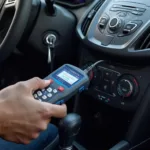Navigating the world of OBD2 scanners can be overwhelming, especially when considering paid software options. With countless choices available, finding the best OBD2 paid software for your needs requires careful consideration. This guide will help you understand the key features to look for, compare popular options, and ultimately empower you to make an informed decision.
Why Invest in Paid OBD2 Software?
While free OBD2 apps might seem appealing, paid software offers significant advantages, particularly for professionals and serious DIY enthusiasts. Here’s why:
-
Advanced Functionality: Paid software unlocks a treasure trove of features not found in free versions, including live data streaming, bi-directional controls, coding and adaptations, and access to manufacturer-specific modules.
-
Comprehensive Coverage: Paid software typically boasts extensive vehicle compatibility, encompassing a wider range of makes, models, and model years.
-
Regular Updates: To stay ahead of the curve with the latest vehicle technology, paid software providers deliver regular updates, ensuring you have the most current information and functionality.
-
Dedicated Support: When facing technical difficulties or seeking expert guidance, paid software often comes with dedicated customer support channels, offering prompt assistance.
Key Features to Consider
When comparing different paid OBD2 software options, pay close attention to these key features:
1. Vehicle Compatibility
Ensure the software supports the make, model, and model year of your vehicle, especially if you own a less common or older car.
2. Diagnostic Capabilities
Look for software that offers a comprehensive range of diagnostic functions, including:
-
Reading and clearing DTCs (Diagnostic Trouble Codes): This is the most basic function of any OBD2 software and should be a given.
-
Live Data Streaming: View real-time sensor data to monitor engine performance, emissions, and other critical parameters.
-
Bi-Directional Controls: Interact with your vehicle’s systems by activating components like solenoids, relays, or actuators to test functionality.
-
Coding and Adaptations: Access and modify control module settings for tasks like key programming, injector coding, or resetting service reminders.
-
ECU (Engine Control Unit) Flashing: This advanced feature allows for updating a vehicle’s software, but should be used with extreme caution.
3. User Interface and Experience
Choose software with an intuitive and user-friendly interface that simplifies navigation and data interpretation. Look for features like:
-
Clear and Concise Data Display: Easily understand and analyze data with well-organized graphs, charts, and tables.
-
Customizable Dashboards: Tailor the display to show the information you need most.
-
Reporting Features: Generate detailed reports for record-keeping, troubleshooting, or sharing with clients.
4. Updates and Support
Verify the software provider’s update policy. Regular updates are essential to maintain compatibility with new vehicle models and address any bugs or security vulnerabilities. Also, check if the software comes with dedicated customer support and documentation.
Making the Right Choice
The “best” OBD2 paid software ultimately depends on your individual needs and budget. Consider these factors when making your decision:
-
Frequency of Use: For occasional DIY use, a more affordable option with essential features might suffice. Professionals using the software daily may benefit from investing in a more comprehensive and expensive package.
-
Skill Level: Beginners may prefer software with a simpler interface and built-in guidance. Experienced users might prioritize advanced features and customization options.
-
Specific Vehicle Requirements: Ensure the software supports your vehicle’s make, model, and any unique diagnostic needs.
Beyond the Software: Choosing the Right Hardware
While this guide focuses on software, remember that you’ll also need a compatible OBD2 scanner to use it. Factors to consider when choosing hardware include:
- Connection Type: Bluetooth, USB, or Wi-Fi
- Compatibility: Ensure compatibility with your chosen software and devices.
- Durability and Build Quality: Invest in a scanner that can withstand the rigors of regular use.
Conclusion
Choosing the best OBD2 paid software requires careful consideration of your individual needs, budget, and the specific features that matter most to you. By understanding the key aspects discussed in this guide, you’ll be well-equipped to make an informed decision and unlock the full diagnostic potential of your OBD2 scanner.

